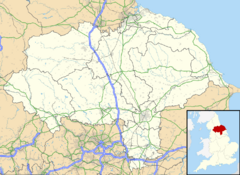Biology:Barkston Ash
| Barkston Ash | |
|---|---|
 Boundary stone on junction of Main Street with the A162 road | |
Location within North Yorkshire | |
| Population | 370 (2011 census)[1] |
| OS grid reference | SE491361 |
| Civil parish |
|
| Unitary authority |
|
| Ceremonial county |
|
| Region | |
| Country | England |
| Sovereign state | United Kingdom |
| Post town | TADCASTER |
| Postcode district | LS24 |
| Dialling code | Template:Infobox UK place/NoDialCode |
| Police | North Yorkshire |
| Fire | North Yorkshire |
| Ambulance | Yorkshire |
Barkston Ash is a small village and civil parish close to Selby in North Yorkshire, England. It was formerly known as Barkston in the West Riding of Yorkshire.[2][3]
History
The village dates back to at least 1090, when it was spelled Barcestone.[3] Now part of Selby district, the village previously gave its name to the former wapentake of Barkston Ash.[4] The Ash part of the name comes from a large ash tree said to be at the approximate centre of the ancient county of Yorkshire, where meetings for the wapentake would be held.[2][5]
What is now the A162 London Road was a turnpike constructed in 1769: the Main Street and the major part of the village goes East from the junction with this.[5]
Barkston Ash was also the name of the local parliamentary constituency of Barkston Ash until 1983, when its boundaries were redrawn to divide the area into Elmet and Selby.[3]
Features
The village contains a small Church of England church, Holy Trinity, originally a chapel of ease constructed in 1880, but given its current name and status in 1974.[5] There are two pubs, the Ash Tree (on the site of a former coaching inn) and the Boot and Shoe, a village hall and a primary school (dating from 1856).[6] There were formerly two shops and a post office on Main Street, now private residences.[3]
There are three 17th to 19th century stone Grade II listed building houses near the junction of Main Street and Church Street: Laurel Farm,[7] Barkston House,[8] and Turpin Hall Farm.[9]
References
- ↑ Template:NOMIS2011
- ↑ 2.0 2.1 Lewis, Samuel. "Barkston". UK Genealogy Archives. https://ukga.org/lewis_eng/B/897.html. "Transcribed from A Topographical Dictionary of England, by Samuel Lewis, 7th edition, published in 1848."
- ↑ 3.0 3.1 3.2 3.3 "About Barkston Ash". Barkston Ash Parish Council. http://barkstonash.co.uk/index.php/about.
- ↑ Langdale, Thomas (1822). A topographical dictionary of Yorkshire; containing the names of all the towns, villages, hamlets, gentlemen's seats, &c. in the county of York. Northallerton: Langdale J. p. 149. OCLC 5211910. https://archive.org/details/atopographicald01langgoog.
- ↑ 5.0 5.1 5.2 North Yorkshire Federation of Women's Institutes (1991). North Yorkshire Village Book. Countryside Books. p. 26. ISBN 978-1853061370.
- ↑ "Barkston Ash Catholic Primary School". http://barkstonash.n-yorks.sch.uk/page.php?id=1966.
- ↑ Historic England. "Laurel Farm (1148434)". National Heritage List for England. https://HistoricEngland.org.uk/listing/the-list/list-entry/1148434.
- ↑ Historic England. "Barkston House (1316334)". National Heritage List for England. https://HistoricEngland.org.uk/listing/the-list/list-entry/1316334.
- ↑ Historic England. "Turpin Hall Farm (1148433)". National Heritage List for England. https://HistoricEngland.org.uk/listing/the-list/list-entry/1148433.
External links
- Barston Ash village website
- The Ancient Parish of Sherburn in Elmet at GENUKI: Barkston Ash was in this parish
 |






